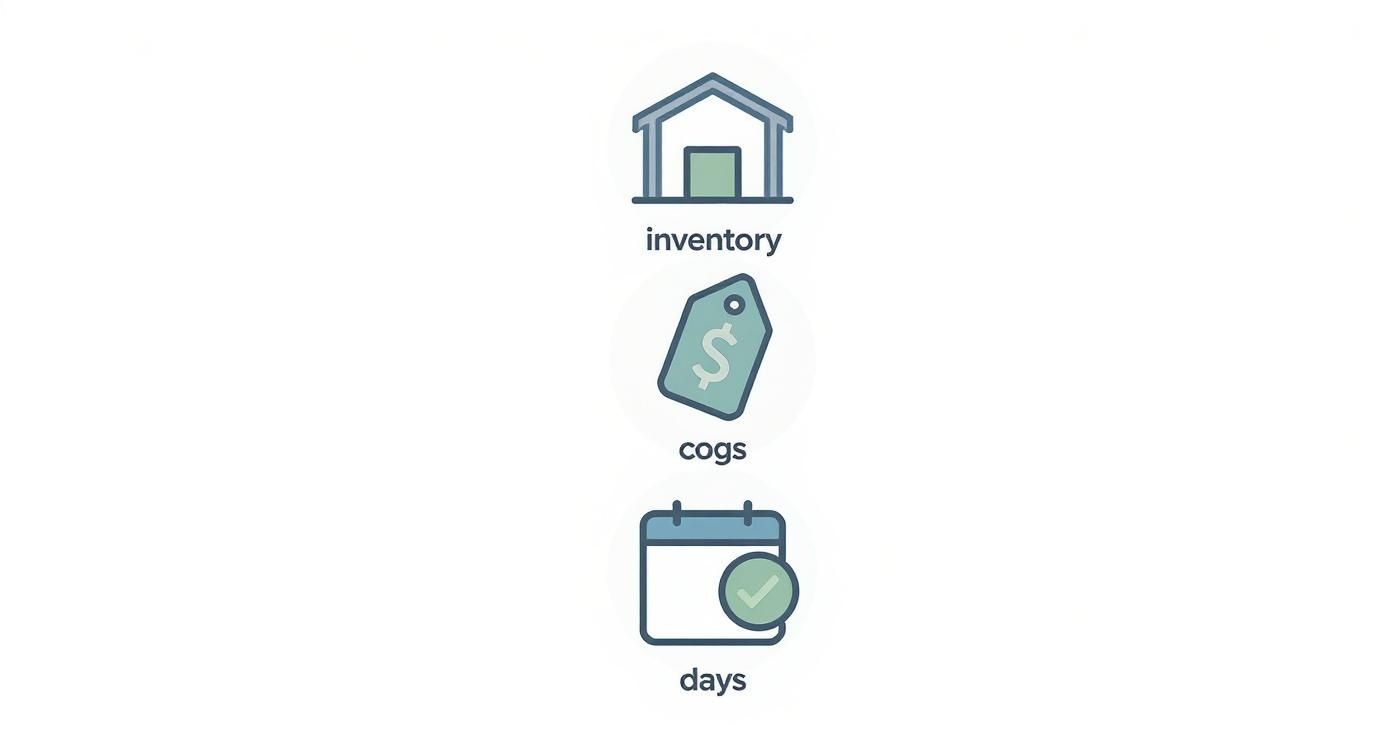Want to know how quickly your inventory turns into cash? There's a simple formula for that:
(Average Inventory / Cost of Goods Sold) × 365
This calculation gives you your inventory days, a key performance indicator (KPI) that's also known as Days Inventory Outstanding (DIO). In plain English, it tells you the average number of days it takes for your business to sell through its entire stock.
A lower number usually points to efficiency, while a higher number can be a red flag for overstocking.
Before we get into the nitty-gritty of the formula, it’s worth understanding why this metric is such a game-changer for any e-commerce brand. At its core, inventory days gives you a direct snapshot of your operational efficiency and cash flow health.
Think of it as your business's pulse—it tells you how quickly the lifeblood of your company (your product) is actually moving.

This straightforward calculation offers a surprisingly powerful look into your supply chain. For instance, major retailers live and die by this number to manage their sprawling operations.
In fiscal year 2021, Target had an average inventory of $9.82 billion and a cost of goods sold of $65.7 billion. Running the numbers, their inventory days figure came out to about 55 days. This means, on average, a product sat in their system for nearly two months before a customer bought it. A single metric like this helps them benchmark against competitors and fine-tune their massive logistics network.
A high or low inventory days figure isn't automatically "good" or "bad" without context. Instead, it’s a critical signal that points you toward specific parts of your business that need a closer look.
The real power of calculating inventory days comes from tracking it over time. It allows you to see trends, measure the impact of marketing campaigns, and make smarter purchasing decisions. It transforms inventory from a static asset into a dynamic indicator of business agility.
Ultimately, knowing your inventory days helps you manage your working capital more effectively. To really appreciate the insights this metric offers, it helps to understand the bigger picture of financial ratio analysis, which is all about interpreting various financial metrics in relation to each other.
By optimizing this number, you ensure capital is flowing through your business efficiently instead of just sitting on warehouse shelves. This is a foundational piece of any strong inventory management strategy.
Alright, let's get down to brass tacks. Moving from theory to practice is where you’ll actually see the value in this metric. I'll walk you through exactly how to calculate inventory days for your business, breaking it down into a manageable process you can use right away.
The good news? The core of this calculation only needs two key figures from your financial records. Once you know where to look, the math is pretty simple.
First things first, you need a balanced view of your inventory's value over a specific period. Just grabbing a single day's inventory number can be really misleading, especially if your stock levels jump around a lot. That's why the best practice is to calculate your average inventory.
To get this number, you'll need two figures from your balance sheet for the period you're measuring (like a fiscal year):
The formula is as straightforward as it gets:
(Beginning Inventory + Ending Inventory) / 2 = Average Inventory
This simple average gives you a much more stable and realistic picture of the inventory you actually held throughout the year.
Next up, you need to find the total cost of all the products you sold during that same period. This figure is your Cost of Goods Sold (COGS), and you can typically find it on your company's income statement.
COGS includes all the direct costs tied to producing or buying the goods you sold—think raw materials and direct labor. It does not include indirect costs like your marketing budget or warehouse rent.
Key Takeaway: Make sure you're using the exact same time frame for both your average inventory and your COGS. If you're looking at annual inventory figures, you must use the annual COGS. Mismatched periods will throw off your numbers and give you a useless result.
Now, let's plug these numbers into the main formula for inventory days and see it in action.
(Average Inventory / COGS) x 365 = Inventory Days
Imagine you run an e-commerce store. Your annual average inventory comes out to $43,780, and your yearly COGS is $373,400.
Here’s the math:
($43,780 / $373,400) x 365 = 42.8
This tells the business owner that, on average, it takes about 43 days to sell through their entire stock of inventory. That's a powerful number to know.
There's another path to the same answer, and it involves a closely related metric: the inventory turnover ratio. This ratio tells you how many times you sell and replace your inventory over a given period.
If you already have that number handy, the math is even easier. If you're not familiar with it, you can check out our guide on how to calculate inventory turnover to get up to speed.
Here's the alternative formula:
365 / Inventory Turnover Ratio = Inventory Days
Let's say a company turns over its inventory 8.5 times a year. Its inventory days would be 365 / 8.5, which lands right around 42.9 days.
This method is a fantastic way to double-check your work. It also really highlights the direct relationship between how often your inventory turns and exactly how long it's sitting on your shelves.
Once you've run the numbers and calculated your inventory days, what you're holding is much more than just a number—it’s a direct snapshot of your business's health and efficiency. Getting the figure is the easy part. The real magic happens when you start interpreting what it tells you about your cash flow, sales velocity, and overall operational muscle.
This single metric can shine a spotlight on hidden problems or validate your winning strategies, but only if you know how to read the signs.
This infographic breaks down the core components you'll need for the calculation.

As you can see, the relationship between your inventory value, the cost of your sales, and time is what gives this metric its diagnostic power.
A high number of inventory days is often a clear signal that cash is trapped on your warehouse shelves. Every single day a product sits unsold, it represents money that could be invested elsewhere—in marketing, new product development, or simply beefing up your cash reserves.
This situation can point to several potential issues brewing under the surface:
A high figure isn't just a financial drain. It also jacks up your carrying costs and dramatically increases the risk of inventory becoming obsolete, especially in fast-moving industries like fashion or consumer electronics.
On the flip side, an extremely low inventory days number isn't automatically a cause for celebration. While it definitely indicates strong sales and high demand, it can also be a red flag for a completely different set of problems.
A number that’s too low might mean you're constantly teetering on the edge of a stockout. This leads to missed sales opportunities, frustrated customers who will gladly turn to your competitors, and skyrocketing shipping costs from frequent, small emergency reorders.
Finding that sweet spot is crucial. You want inventory to move quickly, but not so fast that you can't keep up with customer demand.
To help you visualize what these numbers mean in practice, this table breaks down the good, the bad, and the ugly of high versus low inventory days.
Ultimately, this comparison shows there's a delicate balance. One extreme points to wasted capital, while the other points to missed opportunities.
The key takeaway here is that context is everything. A grocery store selling fresh produce will have a radically different ideal inventory days number than a car dealership. The only way to know if your number is truly healthy for your business is to benchmark your performance against industry averages and your own historical data.
A small error in your calculation can lead to some seriously misguided business strategies. Knowing the formula for inventory days is only half the battle; the real trick is ensuring the numbers you plug into it are clean, accurate, and relevant. Let's walk through the common traps businesses fall into so you can steer clear of them.
Even a simple mistake can dramatically skew your results, making you think your inventory is moving much faster or slower than it actually is. Here are the most frequent errors I see people make.
This is probably the most common—and most damaging—error out there. It happens when you use mismatched time periods for your inventory and Cost of Goods Sold (COGS) data. If you calculate your average inventory for the entire year but only pull COGS from your busiest quarter, your final number will be completely useless.
The fix is simple but absolutely critical: always ensure your average inventory and COGS figures cover the exact same time frame. Whether you're analyzing a month, a quarter, or a full year, the start and end dates have to align perfectly for both sides of the equation. No exceptions.
Relying on a single, annual inventory days figure can mask huge opportunities, especially for businesses with predictable peaks and valleys. Think about a retailer that does 40% of its sales during the holiday rush—an annual average smooths over all the critical details.
That single number won't show you how quickly stock flew off the shelves in December versus how slowly it crawled in February. To get a much clearer picture, you need to dig a little deeper:
This approach gives you a much more nuanced view of your operation than a single, static number for the entire year ever could.
Pro Tip: Take it one step further and analyze inventory days by product category. You might discover that while one category turns over like clockwork, another is a lead weight dragging down your overall average. That's an immediate, actionable insight.
Your inventory days calculation is only as good as the accounting data behind it. Using the wrong cost basis for your inventory or failing to account for all direct costs in your COGS will torpedo your results before you even start.
For instance, a frequent mistake is using retail prices instead of cost prices for inventory value. Another common one is a COGS calculation that omits key expenses like inbound shipping, which throws off your denominator. This is a crucial detail, as accurate costing is the foundation for other key metrics, like the one we cover in our guide to inventory turnover explanation.
The only solution is to maintain clean and precise financial records. Make a habit of auditing your inventory valuation methods (like FIFO or LIFO) and double-checking that your COGS is comprehensive. Clean data is the bedrock of any meaningful business analysis.
Once you have an accurate inventory days number, the real work begins: making that number work for you. A lower DIO means your cash is flowing freely instead of sitting idle on warehouse shelves. Improving this metric is all about boosting your inventory efficiency with smart, practical strategies you can start using today.

The goal here is to strike a healthy balance—moving products quickly without ever running the risk of a stockout. Let's dig into some proven tactics to help you shrink your inventory days and grow your bottom line.
Overstocking is the single biggest cause of a high inventory days figure, and it almost always comes down to guesswork. It's time to stop ordering based on gut feelings and start digging into your historical sales data.
Modern inventory management software can automate a lot of this heavy lifting, pinpointing seasonal trends and predicting future demand with far greater accuracy. Better forecasting lets you order what you need, right when you need it. This one change can dramatically reduce the amount of capital you have tied up in slow-moving products.
Every business has them—those products that just don't sell as quickly as you'd hoped. These items are inflating your average inventory and dragging down your overall efficiency. It’s time to get proactive and get them moving.
Consider these sales-focused approaches:
Clearing out stagnant inventory does more than just lower your inventory days; it also significantly reduces your holding expenses. To see the full financial impact, check out our guide on how to calculate inventory carrying costs.
Your supply chain plays a massive role in how much inventory you need to keep on hand. Long, unpredictable lead times force you to hold more safety stock as a buffer, which directly inflates your inventory days.
Start a conversation with your suppliers. Ask if there are opportunities to shorten their lead times or if they offer more frequent, smaller order quantities. Building a strong, collaborative relationship can lead to more flexible terms that allow you to operate a leaner inventory model. A supplier who understands your goals is a powerful ally.
For businesses ready to take efficiency to the next level, a Just-In-Time (JIT) approach is a game-changer. This model involves ordering and receiving inventory only as it's needed to fulfill customer orders, rather than holding massive volumes of stock.
JIT dramatically cuts down on warehousing needs and minimizes the risk of inventory obsolescence. While it requires incredibly precise coordination and rock-solid, reliable suppliers, the payoff is a significantly lower DIO and a much more agile business. It's the ultimate goal for lean inventory management.
Once you get comfortable with the inventory days formula, a few practical questions almost always come up. Mastering the math is one thing, but knowing how to apply this metric to make better business decisions is where the real value lies.
Let’s clear up some of the most common questions we hear from founders trying to get a handle on their stock.
This is a big one. You might be wondering if this is a daily, weekly, or monthly task. The short answer? It depends on your business's sales cycle and seasonality.
For a business with consistent, year-round sales, running the numbers quarterly might be all you need to spot long-term trends without getting bogged down in minor fluctuations.
But if you run a seasonal business—say, selling swimwear or holiday decorations—calculating inventory days monthly is a far better approach. A monthly check-in will clearly show how your inventory velocity skyrockets during peak season and slows to a crawl in the off-season. This granularity helps you avoid the misleading picture a single annual average can create, allowing for much more precise purchasing and marketing strategies.
This is the golden question, and the honest answer is: it depends entirely on your industry. There's no universal "good" number. A low inventory days figure isn't always a sign of success, just as a high one isn't always a sign of failure.
Context is everything.
Instead of chasing a magic number, focus on benchmarking. The most important comparison is against your own historical performance. Are you improving month-over-month or year-over-year? That's the truest sign of health. After that, see how you stack up against direct competitors.
Absolutely, and you definitely should. Calculating inventory days at the individual product or SKU level is a powerful way to get a much deeper understanding of your catalog's performance. It’s how you find out which products are flying off the shelves and which ones are just tying up cash.
To do this, you just adapt the formula to focus on a single item. You'll need the average inventory value and the COGS for that specific product over whatever time period you're looking at. This kind of granular analysis is fantastic for:
This approach transforms inventory days from a high-level, big-picture metric into a precise, tactical tool you can use to manage your entire product lineup.
Ready to stop worrying about inventory calculations and focus on growing your brand? Simpl Fulfillment integrates directly with your e-commerce platform, providing real-time data and expert logistics so you can optimize your stock and deliver an exceptional customer experience. Learn how we can help at https://simplfulfillment.com.